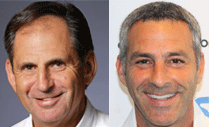
Klaus Schwab, president and founder of the World Economic Forum calls
John Kao "The world's #1 authority on business creativity."
I first encountered him in 1997, discovering his book "Jamming," which was based on the jazz music concept of ad libbing freely and creatively, which is done in an organized framework so that other players can harmonize with you.
Kao maintains that business creativity can be taught. As someone who recruits, supports and trains radio personalities with the belief that it's crucial to our future, I have been applying his techniques since that time.
When he
guested on the Colbert Report four years ago, I saved the video and play it in client seminars when everyone needs a laugh + proof of the power of creativity.
"This is the age of creativity because that's where information technology wants us to go next. In an era the prizes knowledge, creativity adds value to knowledge and makes it progressively more useful. It is the age of creativity because companies are increasingly obliged to reinvent themselves to achieve growth. The customer is boss now - discerning, demanding and no more loyal than he or she has to be. The new boss has only one question: 'so what are you going to do for me tomorrow?' Only creativity can give the answer.
"If I were running a...company today, I would worry late into the night whether I was attracting the right kind of people, especially young people. I would not rest until I could assure myself that creative energy, color, fascination, challenge, even exhilaration could flourish throughout the enterprise. Creative people run best on the high octane fuels of play and freedom. Like combination game masters and patrons of the arts, leaders set direction, inspire, listen, facilitate, provide."
He recommends you audit the creativity of your company, suggesting that highly creative enterprises have greater potential for increasing asset value. As I read Kao's philosophy, I kept thinking how much more these comments apply to radio -- whose major asset value, called "good will" in most corporate prospectuses, exists totally in the minds of our customer listeners and customer advertisers.
Nowhere does creativity add value more directly than in the radio business. Yet, as I talk to our personalities and salespeople, there is a growing fear of being 'too creative' in the midst of the sea change sweeping radio right now. Kao warns: that's trouble.
Kao says: "Jazz - like business - implies a series of balancing acts. It must always be disciplined - but never driven - by formulas, agendas, sheet music. It must always be pushing outward, forward, upward and therefore against complacency. The (creative) role of the manager is to work the central paradox, or tension, of the jam session: to locate the ever-mobile 'sweet spot' somewhere between systems and analysis on the one hand and the free-flowing creativity of the individual on the other.
"Concentration and focus on a problem (which are good things, necessary in today's radio business world) usually narrow our thinking to the tried and true, shutting out access to the vast storehouse of our subconscious imagery and experience."
He suggests employing "beginner's mind" when this lock on creative ideas occurs. Force yourself into a radical change of subject. Forget what you "know" about the tyranny of the given, the known, the 'right' way, the status quo. Look outside for fresh input. We need to know what we don't know, NOT what we DO know.
Kao: "A creative public performance (by an air personality or a presentation by a sales person) is a high wire act with no net. The stakes can be enormous. In addition to open spaces in your work environment, create hiding places - cozy attics where people can go off and make fools of themselves in perfect safety. Could that be YOUR control room?
He notes that there are seven aspects of a well-crafted creative challenge, which is what achieves goals. They apply equally to GM's, SM's, PD's and anyone talking on the air:
Language. Use vivid language. Put everything you have into your speech. Deliver challenges in full costume, rhetorically and visually.
Context. People today are "business and media literate." They are wiser, better prepared than ever to listen to sophisticated messages. But, these messages must come out of a context that they believe and understand, not out of nowhere. This calls for clarity. Challenges you issue out of the blue will go nowhere.
Mouth and money. To be effective, challengers must have the right status -- they have to be in a position to put their money where their mouths are.
Preparation. Creativity is born of experience. Don't jump in with both feet unless you know where you are headed. When you ask people to commit time, energy, emotion and soul, think through what you're doing before you act.
Discipline. When, in 1961, John Kennedy challenged Americans to put a man on the moon he included a deadline. America would not simply put a man on the moon, the country would do so in eight years. Today, no commitment is more persuasive than one that acknowledges the clock and the calendar. Successful challenges are promises - of resources, of moral support, of personal participation and accountability.
Complicity. Challenge yourself as well as your audience or team. Steven Spielberg carried his chair on the set of Indiana Jones and The Temple of Doom. M. Douglas Ivester may be chairman of the Coca Cola Company, but he still makes anonymous store checks and brings insights about selling opportunities back to the corporate mainstream. Challenge yourself to succeed at the same time you dare your employees to pick up the gauntlet. Involve yourself in what you ask listeners to do.
Empathy. This encompasses appreciation of the difficulty of the challenge. Bo Goldman, who wrote the screenplay for the film Scent of a Woman says "when you get successful, the work becomes harder." Make listeners know you understand their lives.
Kao concludes: "It's not enough to be creative if you cannot execute. It's not enough to execute if what you make is something that people don't want. It's not enough to execute and be creative if you don't have the structures and the culture to be viable long-term."
'90s'.
 h Canada Day and U.S. Independence Day now upon us, and we recently asked Australian-born, Keith Urban, about his citizen status in America and he explained why he loves living here.
h Canada Day and U.S. Independence Day now upon us, and we recently asked Australian-born, Keith Urban, about his citizen status in America and he explained why he loves living here.































